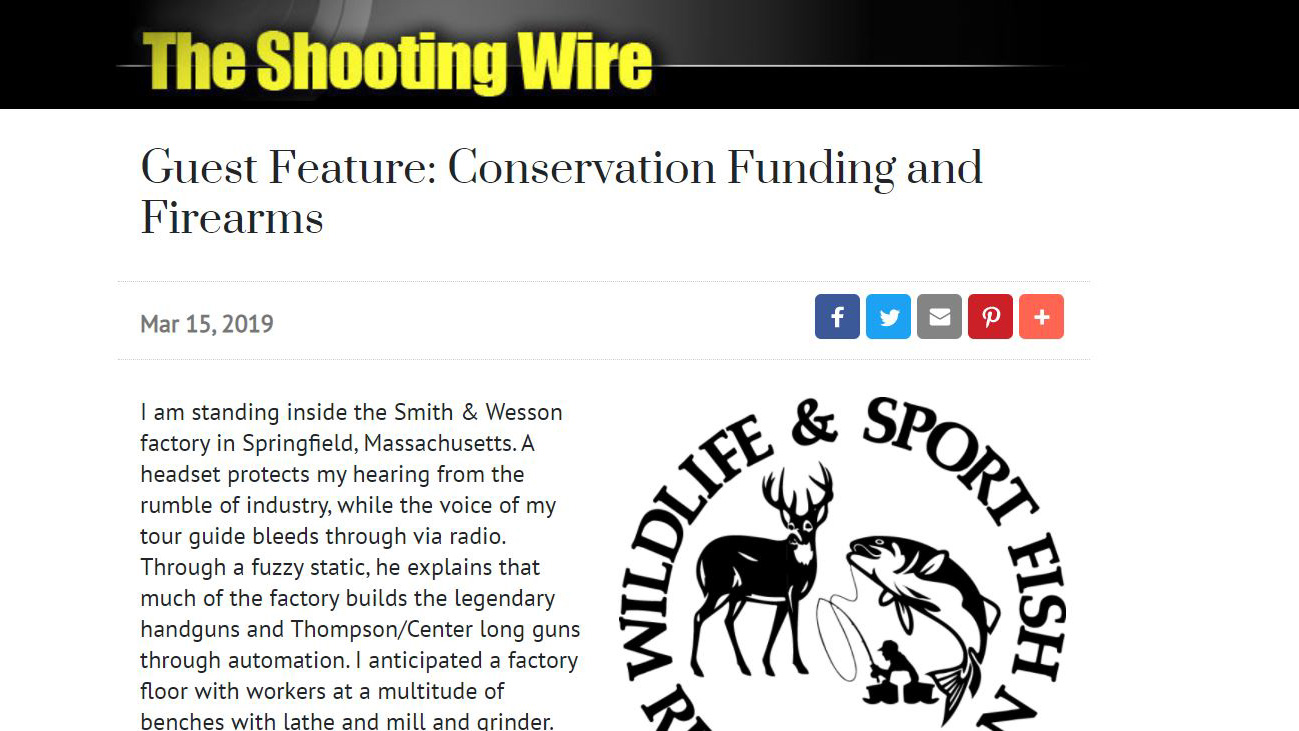This article originally appeared in The Shooting Wire on March 15, 2019.
By Craig Springer, USFWS.
I am standing inside the Smith & Wesson factory in Springfield, Massachusetts. A headset protects my hearing from the rumble of industry, while the voice of my tour guide bleeds through via radio. Through a fuzzy static, he explains that much of the factory builds the legendary handguns and Thompson/Center long guns through automation. I anticipated a factory floor with workers at a multitude of benches with lathe and mill and grinder. Instead, we first walk through a clade of taupe-colored pods, perhaps a dozen or more, each two-thirds the size of a VW bus turned on its tail end.
Each pod is a self-contained machine. You can peer through window glass and see the operation where water, as both lubricant and coolant, jets over milled steel rendered into workable firearm parts.
The factory is certainly not devoid of skilled workers. A woman moves from capsule to capsule, checking LED readouts that show the life left on diamond-tipped tools working inside the microbus-sized mills. Save for maintenance or repairs, my guide says the mills, presses, and forges never stop. Smith & Wesson has been in the firearms business since 1852.
After we viewed the tools used to bore the spiraling grooves inside rifle barrels, we moved by an old display of a Smith & Wesson Model 10 revolver. I had to pause. The dust-covered 4 x 8-foot board showed the progression from raw steel to the formation of the revolver’s constituent parts, and how they fit together to form a fine firearm. The model has been in continuous production for 120 years.
It was there that I felt a celestial spark, a stirring that doesn’t quite have a name.
A decade ago, I inherited a Model 10 from my father at his passing. I was already acquainted with the firearm when it became mine; I learned how to handle a handgun as a boy with that revolver under dad’s tutelage. Dad bought the firearm at the crescendo of America’s bi-centennial, I am sure partly out of patriotic sentiments. He was no stranger to firearms dating to his childhood. As a young soldier, he defended liberty with an M1 Garand and .45 ACP 1911 on the brutal front lines in North Korea in 1951.
In any one of the Smith & Wesson workers, I could see my late brother, a machinist. He was an inventive man who concerned himself with precision and fineness in fabrication. He could speak about the vagaries of tool and die in a parlance that only comes with familiarity.
Through the tour, I heard mallet on metal, squeaky rubber wheels, a rhythmic tick, and the spray of fluids and the pounding of a pneumatic forge on red-hot steel.
These sounds of industry evoke thoughts far removed from the moment: My brother whispers through the patter of rain on the forest floor as we lay in the squirrel woods on a bed of leaves burnished the color of autumn. We look into a silver fog overhead, waiting for a bushytail to bound over a branch. I feel in my forearm the firm, crisp action of my dad’s .22 semi-auto cycle as we plink empty peach cans, aiming at select spots on the labels. My daughter shouts, “There they go!” with the baritone whirr of dusky grouse rising from hummocks of last summer’s exhausted high-country grasses. The thump of my 20-gauge O/U grouse gun on my shoulder comports with the thick pounding of a factory forge.
Building firearms is arguably a first step in securing wildlife conservation. Since 1937, firearms and ammunition manufacturers have paid an 11 percent federal excise tax imposed by the Pittman-Robertson Act that taken together returned $12.2 billion through 2018 to on-the-ground conservation. The tax is a cost of doing business passed on at the sale of the product much like the cost of lacquer on a walnut stock. Someone who buys a new firearm or a box of .30-06 cartridges is paying for a whole lot more.
The Wildlife and Sport Fish Restoration Program of the U.S. Fish and Wildlife Service administers these excise tax dollars that go to your state fish and game departments. Those departments contribute science-based wildlife management for the American public. Your dollars pay for a radio-tracking collar around a mule deer’s neck in the West; bobwhite quail traps in Oklahoma; gas in a biologist’s truck in Alabama, not to mention salary; hunter education classes at a community center in New York; a new shooting range in the Midwest; habitats restored benefiting multitudes of organisms. The tax buys more land—more wildlife management areas—for a hunter to sit in the squirrel woods on a damp morning in the first breath of autumn.
Beneath the busy pods on the Smith & Wesson floor, tools shape steel into enduring products that in short order will contribute to conservation. Conservation is an investment in the future. It’s made possible by an enduring law that after eight decades stands as testament to a partnership between American manufacturers, state and federal governments—and the people who hunt and shoot.







